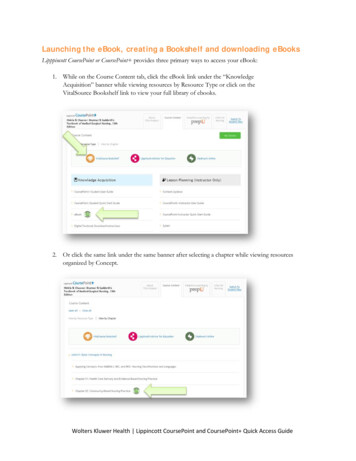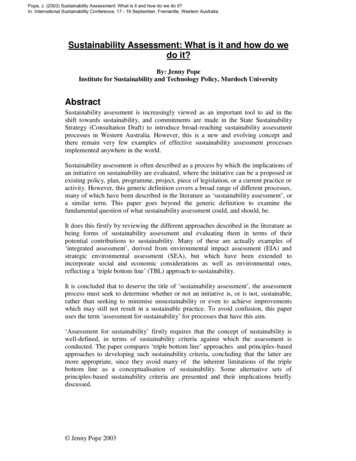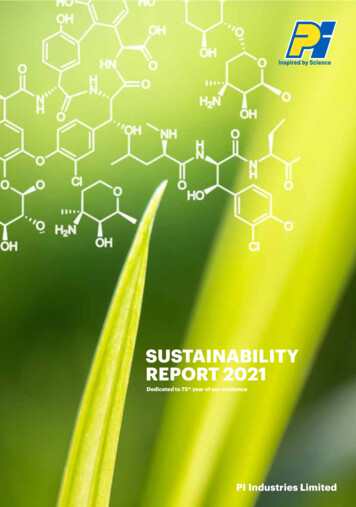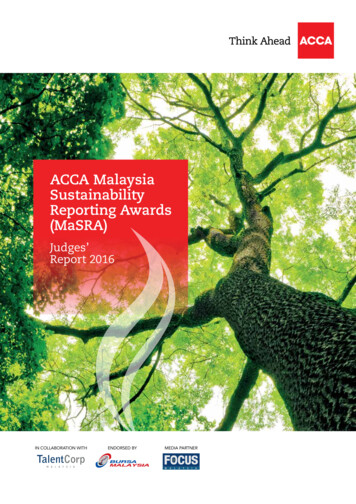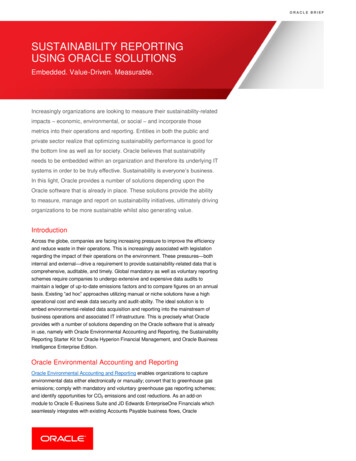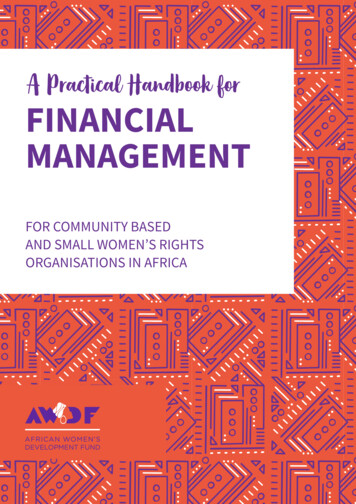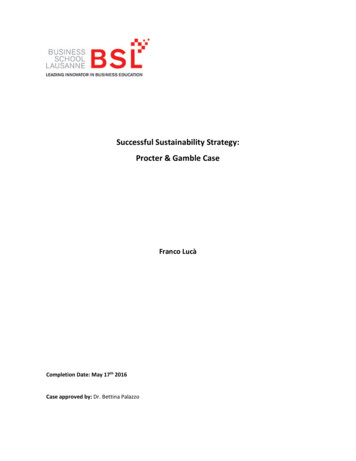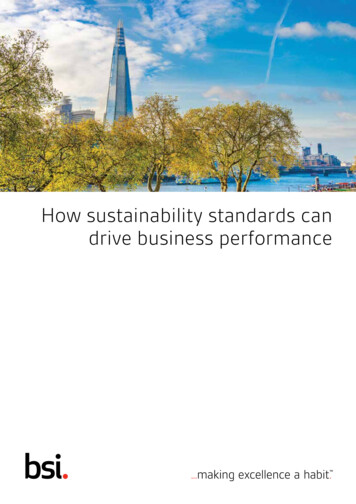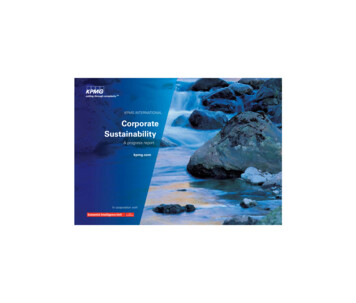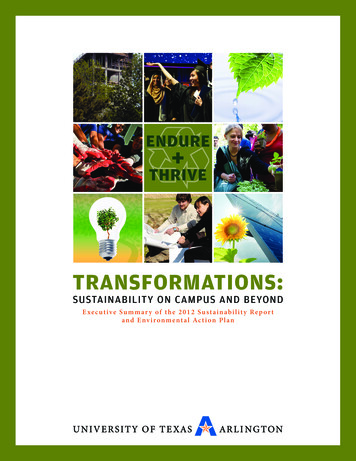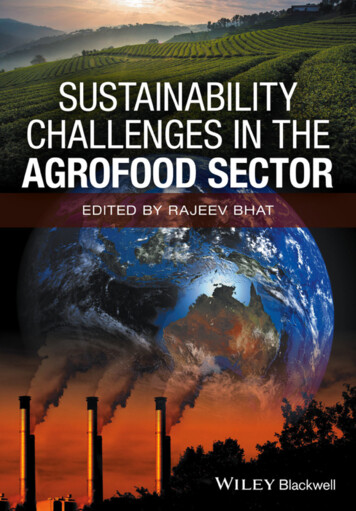
Transcription
Sustainability Challenges inthe Agrofood Sector
Sustainability Challenges inthe Agrofood SectorEdited by Rajeev BhatFood Science Department, College of Engineering, Science &Technology (CEST), School of Sciences, Campus – Nabua,Fiji National University, Fiji Islands
This edition first published 2017 2017 by John Wiley & Sons LtdRegistered OfficeJohn Wiley & Sons Ltd. The Atrium, Southern Gate, Chichester, West Sussex, PO19 8SQ, UKEditorial Offices9600 Garsington Road, Oxford, OX4 2DQ, UKThe Atrium, Southern Gate, Chichester, West Sussex, PO19 8SQ, UK111 River Street, Hoboken, NJ 07030‐5774, USAFor details of our global editorial offices, for customer services and for information about how toapply for permission to reuse the copyright material in this book please see our website atwww.wiley.com/wiley‐blackwell.The right of the author to be identified as the author of this work has been asserted in accordance with theUK Copyright, Designs and Patents Act 1988.All rights reserved. No part of this publication may be reproduced, stored in a retrieval system, ortransmitted, in any form or by any means, electronic, mechanical, photocopying, recording or otherwise,except as permitted by the UK Copyright, Designs and Patents Act 1988, without the prior permission ofthe publisher.Designations used by companies to distinguish their products are often claimed as trademarks. All brandnames and product names used in this book are trade names, service marks, trademarks or registeredtrademarks of their respective owners. The publisher is not associated with any product or vendormentioned in this book.Limit of Liability/Disclaimer of Warranty: While the publisher and author(s) have used their bestefforts in preparing this book, they make no representations or warranties with respect to the accuracyor completeness of the contents of this book and specifically disclaim any implied warranties ofmerchantability or fitness for a particular purpose. It is sold on the understanding that the publisher isnot engaged in rendering professional services and neither the publisher nor the author shall be liable fordamages arising herefrom. If professional advice or other expert assistance is required, the services of acompetent professional should be sought.Library of Congress Cataloging‐in‐Publication DataNames: Bhat, Rajeev, editor.Title: Sustainability challenges in the agrofood sector / edited by Rajeev Bhat.Description: Oxford, UK; Hoboken, NJ : John Wiley & Sons, 2017. Includes bibliographical references and index.Identifiers: LCCN 2016046880 ISBN 9781119072768 (cloth) ISBN 9781119072751 (epub)Subjects: LCSH: Sustainable agriculture. Food industry and trade–Environmental aspects.Classification: LCC S494.5.S86 S84 2017 DDC 338.1–dc23LC record available at https://lccn.loc.gov/2016046880A catalogue record for this book is available from the British Library.Wiley also publishes its books in a variety of electronic formats. Some content that appears in print may notbe available in electronic books.Cover images (top to bottom): [Genesis] - Korawee Ratchapakdee/Gettyimages; Marcel Clemens/Shutterstock; Len Green/ShutterstockSet in 10/12pt Warnock by SPi Global, Pondicherry, India10987654321
vContentsList of Contributors viiiForeword xiiiPreface xviIntroductory Note: Future of Agrofood Sustainability xviii1 Food Sustainability Challenges in the Developing World 1Rajeev Bhat2 The Role of Small‐scale Farms and Food Security 33John McDonagh, Maura Farrell and Shane Conway3 Sustainability Challenges, Human Diet and Environmental Concerns 48Christian J. Reynolds, Jonathan D. Buckley, Philip Weinstein andJohn Boland4 Sustainable Challenges in the Agrofood Sector: The EnvironmentFood–Energy–Water Nexus 78Chanathip Pharino5 Dynamics of Grain Security in South Asia: Promoting Sustainabilitythrough Self‐sufficiency 103Ghose Bishwajit, Sharmistha Ghosh and Jose Renato Peneluppi, Jr.6 Local Food Diversification and Its (Sustainability) Challenges 119Eni Harmayani, Lily Arsanti Lestari, Puspita Mardika Sari andMurdijati Gardjito7 Sustainable Supply Chain Management in Agri‐food Chains:A Competitive Factor for Food Exporters 150Ulla Lehtinen8 How Logistics Decisions Affect the EnvironmentalSustainability of Modern Food Supply Chains: A Case Study froman Italian Large‐scale Retailer 175Riccardo Accorsi, Riccardo Manzini and Chiara Pini
viContents9 Strengthening Food Supply Chains in Asia: Challenges and Strategies 197Sapna A. Narula and Kalpana Vishnoi10 Revolutionizing Food Supply Chains of Asia through ICTsSapna A. Narula21211 Sustainability, Materiality and Independent External Assurance:An Exploratory Study of the UK’s Leading Food Retailers 227Peter Jones, Robin Bown, David Hillier and Daphne Comfort12 Environmental Sustainability of Traditional Crop Varieties:Reviewing Approaches and Key Issues for a Multilevel Evaluation 255Alessandro K. Cerutti, Dario Donno, Maria Gabriella Mellanoand Gabriele L. Beccaro13 Cradle‐to‐gate Life Cycle Analysis of Agricultural and Food Productionin the US: A TRACI Impact Assessment 274Yong Shin Park, Gokhan Egilmez and Murat Kucukvar14 Ensuring Self‐sufficiency and Sustainability in the Agrofood Sector:Sustainability Challenges in Agriculture and Modelling 307Prashant Goswami and Shivnarayan Nishad15 Sustainability Challenges Involved in Use of Nanotechnologyin the Agrofood Sector 343Gabriela Elena Viacava, Francisco Javier Vázquez, Jesús F. Ayala‐Zavala andMaría R. Ansorena16 Sustainability of Nutraceuticals and Functional Foods 369Santad Wichienchot and Wan Rosli Wan Ishak17 Innovation and Sustainable Utilization of Seaweeds as Health Foods 390Fook Yee Chye, Birdie Scott Padam and Seah Young Ng18 Agrofoods for Sustainable Health Benefits and Their Economic ViabilityZakia Khanam and Irshad Ul Haq Bhat19 Sustainability Challenges in Food TourismYeoh Tow Kuang and Rajeev Bhat45120 Diversification, Innovation and Safety of Local Cuisines andProcessed Food Products: Emerging Issues andthe Sustainability Challenges 482Yeoh Tow Kuang and Rajeev Bhat21 Soil Health, Crop Productivity and Sustainability ChallengesKulandaivelu Velmourougane and DeSouza Blaise509435
Contents22 Analysing the Environmental, Energy and Economic Feasibilityof Biomethanation of Agrifood Waste: A Case Study from Spain 532Almudena González González, Francisco Cuadros Blázquez andFrancisco Cuadros Salcedo23 Agricultural Waste for Promoting Sustainable Energy 551Thi‐Thu‐Huyen Do and Thi‐Thu‐Hang Pham24 Membrane Technology in Fish‐processing Waste Utilization:Some Insights on Sustainability 575Wirote Youravong and Sutida Marthosa25 Sustainability Issues, Challenges and Controversies Surroundingthe Palm Oil Industry 596Piyarat Boonsawang and Wirote Youravong26 Sustainability Challenges in the Coffee Plantation Sector 616Kulandaivelu Velmourougane and Rajeev Bhat27 Food Safety Education: Training Farm Workers in the US FreshProduce Sector 643Angela M. Fraser and Otto D. Simmons28 Sustainability Challenges and Educating People Involved inthe Agrofood Sector 660Caroline Opolski MedeirosIndex675vii
List of ContributorsRiccardo AccorsiRajeev BhatDepartment of Industrial EngineeringUniversity of Bologna Alma MaterStudiorumBologna, ItalyFood Science DepartmentCollege of EngineeringScience & Technology (CEST)School of SciencesCampus – NabuaFiji National UniversityFiji IslandsMaría R. AnsorenaChemical Engineering DepartmentFood Engineering GroupEngineering FacultyNational University of Mar del PlataMar del Plata, Buenos Aires, Argentina;National Research Council (CONICET)Mar del PlataBuenos Aires, ArgentinaGhose BishwajitSchool of Social MedicineTongji Medical CollegeHuazhong University of Science andTechnologyWuhan, ChinaJesús F. Ayala‐ZavalaDeSouza BlaiseCentro de Investigación en Alimentacióny DesarrolloHermosilloSonora, MéxicoCentral Institute for CottonResearchICAR, NagpurMaharashtra, IndiaGabriele L. BeccaroFrancisco Cuadros BlázquezDepartment of AgricultureForestry and Food ScienceUniversity of TorinoGrugliasco (TO), ItalyDepartment of Applied PhysicsUniversity of ExtremaduraBadajoz, SpainIrshad Ul Haq BhatCentre for Industrial and AppliedMathematicsand the Barbara Hardy InstituteUniversity of South AustraliaAustraliaFaculty of Earth ScienceUniversiti Malaysia KelantanCampus Jeli, JeliKelantan, MalaysiaJohn Boland
List of ContributorsPiyarat BoonsawangDario DonnoDepartment of Industrial BiotechnologyFaculty of Agro‐IndustryPrince of Songkla UniversityHat Yai, ThailandDepartment of AgricultureForestry and Food ScienceUniversity of TorinoGrugliasco (TO), ItalyRobin BownGokhan EgilmezThe Business SchoolUniversity of GloucestershireCheltenham, UKJonathan D. BuckleyAlliance for Research in ExerciseNutrition and ActivitySansom Institute for Health ResearchUniversity of South Australia, AustraliaAlessandro K. CeruttiDepartment of AgricultureForestry and Food ScienceUniversity of TorinoGrugliasco (TO), Italy;IRIS (Interdisciplinary Research Instituteon Sustainability)University of TorinoTorino, ItalyFook Yee ChyeFaculty of Food Science and NutritionUniversiti Malaysia SabahKota KinabaluSabah, MalaysiaDaphne ComfortThe Business SchoolUniversity of GloucestershireCheltenham, UKDepartment of Mechanical and IndustrialEngineeringUniversity of New HavenWest HavenCT, USAMaura FarrellSchool of Geography & ArchaeologyNUI GalwayGalway, IrelandAngela M. FraserClemson UniversityDepartment of FoodNutritionand Packaging SciencesClemson, SCUSAMurdijati GardjitoUniversitas Gadjah MadaPusat Studi Pangan Dan GiziGedung PauJl. Teknika UtaraBarek, YogyakartaIndonesiaSharmistha GhoshSchool of Geography & ArchaeologyNUI Galway, Galway, IrelandSchool of Public AdministrationHuazhong University of Science andTechnology, WuhanHubei, ChinaThi‐Thu‐Huyen DoAlmudena González GonzálezInstitute for Environment and ResourcesVietnam National UniversityHo Chi Minh City, VietnamDepartment of Applied PhysicsUniversity of ExtremaduraBadajoz, SpainShane Conwayix
xList of ContributorsPrashant GoswamiMurat KucukvarCSIR National Institute for ScienceTechnology and Development StudiesNew Delhi, IndiaAssistant ProfessorDepartment of Industrial EngineeringIstanbul Sehir University, TurkeyEni HarmayaniUlla LehtinenUniversitas Gadjah MadaCenter for Food and Nutrition StudiesPAU BuildingJl. Teknika UtaraBarek, YogyakartaIndonesiaSenior Research FellowOulu Business SchoolOulu University, FinlandLily Arsanti LestariCentre for Police SciencesUniversity of South WalesPontypridd, UKUniversitas Gadjah MadaPusat Studi Pangan Dan GiziGedung PauJl. Teknika UtaraBarek, YogyakartaIndonesiaWan Rosli Wan IshakRiccardo ManziniDavid HillierSchool of Health SciencesUniversiti Sains MalaysiaHealth CampusKubang KerianKota BharuKelantanMalaysiaPeter JonesThe Business SchoolUniversity of GloucestershireCheltenham, UKZakia KhanamFaculty of Agro Based IndustryUniversiti Malaysia KelantanCampus Jeli, JeliKelantanMalaysiaYeoh Tow KuangSchool of Hospitality,Tourism and Culinary ArtsTaylor’s UniversitySubang Jaya,Selangor, MalaysiaDepartment of Industrial EngineeringUniversity of Bologna Alma MaterStudiorum, Bologna, ItalySutida MarthosaDepartment of Industrial ManagementTechnologyFaculty of Science and IndustrialTechnologyPrince of Songkla UniversityThailandJohn McDonaghSchool of Geography & ArchaeologyNUI GalwayGalway, IrelandCaroline Opolski MedeirosDepartment of NutritionFederal University of ParanáCuritiba, PR, BrazilMaria Gabriella MellanoDepartment of AgricultureForestry and Food ScienceUniversity of TorinoGrugliasco (TO), Italy
List of ContributorsSapna A. NarulaChanathip PharinoDepartment of Business Sustainability,TERI UniversityNew Delhi, IndiaAssociate ProfessorDepartment of EnvironmentalEngineeringChulalongkorn UniversityBangkok,ThailandSeah Young NgFaculty of Food Science and NutritionUniversiti Malaysia SabahKota KinabaluSabah, MalaysiaShivnarayan NishadDepartment of MathematicsFaculty of Science and HumanitiesMS Ramaiah University of AppliedSciences, BangaloreIndiaBirdie Scott PadamFaculty of Food Science and NutritionUniversiti Malaysia SabahKota KinabaluSabah, MalaysiaYong Shin ParkUpper Great Plains TransportationInstitute (UGPTI)North Dakota State UniversityFargo, NDUSAJose Renato Peneluppi, Jr.School of Public Administration,Huazhong University of Science andTechnology,Wuhan, HubeiChina;Visiting ResearcherThe University of Oslo, OsloNorwayThi‐Thu‐Hang PhamInstitute for Environment and ResourcesVietnam National UniversityHo Chi Minh CityVietnamChiara PiniDepartment of IndustrialEngineeringUniversity of Bologna Alma MaterStudiorumBolognaItalyChristian J. ReynoldsDepartment of GeographyFaculty of Social SciencesThe University of SheffieldSheffield, UK;Centre for Industrial andApplied Mathematicsand the Barbara Hardy InstituteUniversity of South AustraliaAustraliaFrancisco Cuadros SalcedoDepartment of Applied PhysicsUniversity of ExtremaduraBadajoz, SpainPuspita Mardika SariUniversitas Gadjah MadaPusat Studi Pangan Dan GiziGedung Pau, Jl. Teknika UtaraBarek, YogyakartaIndonesiaOtto D. SimmonsDepartment of Biological andAgricultural EngineeringNorth Carolina State UniversityRaleigh, NC, USAxi
xiiList of ContributorsFrancisco Javier VázquezPhilip WeinsteinCentro de Investigación en Alimentacióny Desarrollo,HermosilloSonora, MéxicoSchool of Pharmacy and MedicalSciencesDivision of Health Science, and theBarbara Hardy InstituteUniversity of South AustraliaAustralia and School of BiologicalSciences, University of Adelaide,AustraliaKulandaivelu VelmourouganeCentral Institute for Cotton ResearchICAR, NagpurMaharashtra, IndiaGabriela Elena ViacavaChemical Engineering DepartmentFood Engineering GroupEngineering Faculty,National University of Mar del PlataMar del Plata,Buenos Aires, Argentina;National Research Council (CONICET)Mar del Plata,Buenos Aires, ArgentinaKalpana VishnoiResearch Associate (formerly);All India Coordinated Project onPesticide Residues,IARI, New Delhi,IndiaSantad WichienchotInterdisciplinary Graduate School ofNutraceutical and Functional FoodPrince of Songkla UniversityHat Yai, SongkhlaThailandWirote YouravongDepartment of Food Technology,Faculty of Agro‐IndustryMembrane Science and TechnologyResearch CenterPrince of Songkla University,Hat YaiThailand
xiii ForewordProposed solutions for feeding the world’s population while protecting the environmentare rife with theories and examples, few of which can be applied globally. Much of thechallenge lies in the understanding of what ‘sustainable’ really means, and what compromises people are prepared to accept between price of food, agricultural system inwhich it was produced and environmental impacts. The conundrum of achieving production and protection is termed a ‘wicked’ problem – and the information in this bookbrings to the fore some sensible steps towards potential success.Food in developed countries is cheaper, more varied, more prepared and safer to eatthan it has ever been in the past. Understandably, people in developing countries wantthe same opportunity to eat inexpensive, varied, easy‐to‐access, safe food. The problemis that the production of any food has unintended consequences. The very act of harvesting and digesting plant material separates the carbon and nitrogen that the planthas combined during photosynthesis, and returns chemicals surplus to the nutrientrequirements of the digester to the environment. The ‘return’ usually occurs in a different place from the harvesting, thereby causing potential problems. This is particularlythe case for the chemicals in dung and urine which the animal deposits on the soil inconcentrated form. In addition, the form of the chemicals excreted is different from thatingested. A small proportion of the carbon dioxide from the atmosphere combined during photosynthesis is returned to the atmosphere as methane by ruminants. Nitrogen isconverted by various processes variously to nitrate and nitrous oxides. Methane andnitrous oxides are of concern in the greenhouse gas calculations; nitrate can become acontaminant in waterways.A further problem for agriculture is the impact of animals and machinery on soil.Erosion from fields and paddocks becomes sediment in lakes and rivers, carrying nutrients such as phosphorus with it. Micro‐organisms such as faecal coliforms can also beinvolved.Keeping animals in high‐tech shelters allows excreta to be ‘managed’, thereby reducing impact on the environment, but feeding them requires mechanical harvesting ofcrops, potentially impacting negatively on the soil whilst using fossil fuel and creatingmore greenhouse gases. In addition, housing of animals in large numbers increases thelikelihood of disease, and consequently the use of antibiotics.And on all systems the pressure to increase productivity is high: equipment hasbecome larger; chemicals to reduce insect, weeds and diseases have become more specific; and all chemicals, including fertilisers, have been applied with more precision.
xiv ForeworAs a result, productivity has increased, and the risks to production have decreased,particularly where irrigation is available to compensate for lack of rainfall, and frostprotection can be used to mitigate low temperatures.The overall effect has been seen in prices: food is cheaper as a proportion ofincome in developed countries than it has ever been. However, the effect has alsobeen seen on the environment. Waterways are carrying greater sediment loads,with more nutrients.This impact is seen in developed countries as being unsustainable. Protecting thepotential of soil and water to meet the needs of future generations is the third tenet ofsustainability in Smyth and Dumanski’s 1993 discussion paper FESLM: An internationalframework for evaluating sustainable land management (published by the Food andAgricultural Organization of the United Nations). Building on increased productivityand decreased risk to production, the Smyth and Dumanski concept of protectionincluded the suggestion that additional conservation priorities, such as maintaininggenetic diversity or preserving individual plant or animal species, would be needed.Conservation puts the emphasis on improved productivity and reducing risk to production if the population is increasing. The last two tenets of the Smyth and Dumanskiframework are economic viability and social acceptability.The latter includes animal welfare and human welfare: are the animals in the production system being treated humanely and with respect for life? Are the employees receiving a living wage, operating in a safe environment with reasonable hours and holidays?Both are compromised if the prices paid for the product don’t cover the cost of production. This threatens economic viability, and reduces the ability to attract into and retaingood people in agriculture, all along the value chain from farm to fork, or soil to saliva.Research, development and technologies are required in all countries to ensure thatfarmers and growers are able to operate efficiently and are enabled to adapt the newtechnologies to their operation.Part of the research must be on what Smyth and Dumanski term ‘indicators, criteriaand thresholds’. Indicators are environmental statistics that measure or reflect environmental status or change in condition (for example tonnes/ha of erosion; rate of increase/decrease in erosion). Criteria are standards or rules (models, tests or measures) thatgovern judgements on environmental conditions (such as impact assessment of thelevel of erosion on yield, water quality etc.). Thresholds are levels beyond which a system undergoes significant change – points at which stimuli provoke response (forexample a level beyond which erosion is no longer tolerable).The recognition of ‘thresholds’ (by applying ‘criteria’ to measurements of ‘indicators’)will provide powerful tools in deciding whether or not a chosen land use will be sustainable. At the moment, most countries are still in the discussion phase rather than in theagreement or action phases.At the same time it is vital that society as a whole understands the issues – that everytime they throw food away they are not only creating the potential for greenhouse gasgeneration during decomposition but also wasting the chemicals, including water, thatwent in to creating the food; that each time they make a cheap choice in the supermarket, they are increasing the pressures on farmers and growers to increase productivity,with potential impacts on the environment.
ForeworThere are no easy answers, but every single person has an influence through choicesmade. Sustainability Challenges in the Agrofood Sector will help inform those choices,and the path to action. Finally, my appreciation goes to the editor (Dr Rajeev Bhat) andall the authors for their expert inputs provided on various challenging and emergingsustainability issues discussed in this book.Dr. Jacqueline S. RowarthFormerly Professor of Agribusiness, The University of WaikatoHamilton, New Zealand; Chief Scientist (Currently)Environmental Protection Authority, Lambton QuayWellington, New Zealandxv
xviPreface‘Agrofood sustainability’ is a strategic term in the present world scenario with severalnovel and impressive works being proposed and pursued by various researchers, academicians and policymakers around the world. This book takes a comprehensiveapproach to identify various challenges offered by agrofood (agrifood) sustainability.On a global level, several critical factors cover the issues pertaining to sustainabilitychallenges in the agrofood sector. Transforming and communicating lab‐ or office‐ generated knowledge to the local population is an important phase to face the overwhelming sustainability challenges in the agrofood sector.The overall outlook of this book concerns the current knowledge and challengesincurred in the agrofood sector with an onward focus on the future of sustainability.Various multidisciplinary aspects and a range of topics have been covered by leadinginternational experts who have endeavoured to update and provide the latest information on sustainability challenges from around the world. The sustainability issues covered in the chapters includes those concerning the impact of environment or climaticchanges on the agrofood sector, the food—water—energy nexus, geopolitical and climatic unrest, supply chain management, challenges incurred in the food crops sector,food diversification issues, diet and health effects, food waste, sustainable food processing technologies, food tourism, the importance of judicial and regulatory issues andeducating consumers on the significance of sustainability. All the experts have exploredand identified existing gaps and have tried to propose innovative solutions, which canbe implemented to benefit local populations (consumers) around the world.As the book takes an ‘easy to read’ approach with up‐to‐date information, it will benefit all those who are engaged in teaching undergraduate and postgraduate students,agrofood scientists, industrial professionals and policymakers as a readily assessablereference material. Until now, there have been no books in the market which have contained the views of so many leading researchers/experts from different countries.I thank all the authors who had contributed to this book, way before the stipulateddeadline. Much appreciation goes to my present Vice‐Chancellor, Professor NigelHealey of Fiji National University, Fiji Islands for all the support.My sincere gratitude and indebtedness go to all the members of the Wiley‐Blackwellpublishing team involved in this book, for their sincere commitment and enormoussupport. A special note of appreciation goes to Professor Dr Karl R. Matthews(Rutgers University, USA) and to Professor Dr Jacqueline Rowarth (University of
PrefaceWaikato, New Zealand and currently Chief Scientist, Environmental ProtectionAuthority, Wellington, New Zealand) for writing the introductory notes and foreword, respectively. I am also grateful to my wife, Ranjana, and daughter, Vidhathri,for all their benefaction and patience, and I dedicate this book to them with much love.Dr Rajeev Bhatxvii
xviiiIntroductory Note: Future of Agrofood SustainabilityKarl R. MatthewsDepartment of Food Science, Rutgers University, NJ, USAThe global population is projected to increase to more than nine billion by 2050.Concomitantly, the global food demand will double and strain agrofood supply chains.Now is an interesting time where dietary habits of consumers in developed countrieshave led to a seemingly exponential increase in the clinically overweight, while in developing countries food insufficiency results in starvation. Astonishingly, in developedcountries high percentages of food never make it to market, often exceeding the entirefood production of certain regions of the world.Food is essential to life. One of the greatest threats to a healthy environment is agriculture. Seeking a balance to achieve food sustainability is not a trivial task. A seismicshift in consumer preference is underway. This is linked to the desire to have foodswhich are functional in nature and nutritious. The advent of foods developed based onthe genetic profile of a consumer is not out of reach. Simply increasing food productionwill not satiate the appetite of the world’s population. In the future, the primary sourceof protein may shift from being meat‐based to being insect‐based. Such changes will bedifficult to accept for consumers from parts of the world for which insects have notbeen part of the diet. The extent to which such a shift will impact the environment willlikely not be realized until well into the future.Foods that are functional, medicinal and medical must be developed particularly forfeeding developing countries. The utilization of highly nutritious ingredients such asseaweed, algae and kale that are not cost prohibitive and can achieve health and well‐beingis paramount. The food must also be safe and free from chemical and microbiologyhazards that negatively impact human health. Achieving a safe food supply requireseducation and training. An unintended consequence of focusing only on ‘yield per acre/hectare’ is the abuse of chemicals: pesticides, fertilizers, herbicides. The use of moderngenetics such as the clustered regularly interspaced short palindromic repeats (CRISPR)interference technique can be used to modify the genes of food crops without the stigmaof GMOs. Agricultural and processing practices must incorporate effective training andstrategies to provide foods intended to be consumed raw that are microbiologically safe.Each year, millions of cases of foodborne illness linked to foods contaminated withviruses, bacteria and parasites occur in part because of a lack of worker training andconsumer knowledge.
Introductory Note: Future of Agrofood SustainabilityThe development and strengthening of food supply chains is needed to shift foodfrom abundant areas to areas of need. Incredibly, malnourishment occurs in countriesthat have adequate food production. The global agrofood supply chain is under stress.In some regions, more than 50% of the food supply is imported. Measures must betaken to provide market access to small producers, a step that may alleviate some of thesupply chain stress. Indeed, failure to address supply chain issues can contribute toother concerns such as food waste. Food waste for low‐income countries typicallyoccurs during production, while in developed countries it occurs at consumption.Astonishingly, it has been estimated that between 30 and 50% of all food producedaround the world is lost or wasted. Combatting food waste requires the development ofspecific approaches for developed and developing countries. There is no one‐size‐fits‐allsolution.The technology required to initiate and achieve sustainability need not be complex orsophisticated. Government and development agencies often forgo simplicity in favourof high‐tech methods since they draw greater appeal and awe. That said, the appropriate use of technology can significantly move forward sustainability. Nanotechnologyhas potential application in nanofilters and nanobiocides; hurdles exist, however, in theform of public perception and environmental impact. Implementation of measures topromote sustainability along the entire food chain including processing is paramount.Vertical greenhouses in urban settings are viable with the advent of new technologiesthat can control environmental conditions, nutrient and water usage with minimal useof scarce land.Agricultural practices currently implemented result in high productivity but arebased on a strong dependence on natural resources such as water, nutrients (e.g. phosphorus), and fossil fuels. This is underscored by estimates that greater than 1.4 billionpeople live where water cannot meet agricultural and environmental needs. This modelis not sustainable to feed a population projected to reach nine billion by 2050. Newproduction paradigms that make the agrofood system more sustainable are needed.Agrofood sustainability will be achieved through the interdependency between infrastructure, production, distribution and environmental resources. The topic areas covered in this book highlight the diversity required to achieve agrofood sustainability. Thebook begins with chapters exploring food security, the environment food–energy–waternexus and discussion of Asia food supply chains. Shifts in diet and desire for functionality of food are highlighted in several chapters, including exploring contribution of localcuisines and food tourism. The closing chapters address several commodity areas ofglobal significance and the need for training and educating farm workers and thoseinvolved in the agrofood sector.xix
11Food Sustainability Challenges in the Developing WorldRajeev BhatFood Science Department, College of Engineering, Science & Technology (CEST) School of
Center for Food and Nutrition Studies PAU Building Jl. Teknika Utara Barek, Yogyakarta Indonesia David Hillier Centre for Police Sciences University of South Wales Pontypridd, UK Wan Rosli Wan Ishak School of Health Sciences Universiti Sains Malaysia Health Campus Kubang Kerian Kota Bharu Kelantan Malaysia Peter Jones The Business School
